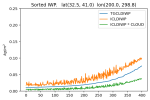From the variable documentation, and in my CAM history files, I see the following:
TGCLDIWP Total grid-box cloud ice water path kg/m2 dims=('time', 'lat', 'lon')
ICLDIWP In-cloud ice water path kg/m2 dims=('time', 'lev', 'lat', 'lon')
I initially assumed that ICLDIWP was the total kg of cloud ice in a (lat,lon,lev) voxel divided by the Earth surface area under that voxel, and that TGCLDIWP was the total kg of cloud ice in the column above a (lat,lon) grid cell divided by the area of that cell. In that case, I should have TGCLDIWP =~ ICLDIWP.sum('lev') but this is not what I see in my data.
Can someone help me understand these two variables?
Possibly related:
* What does "path" signify here? I would imagine a distance travelled, but that doesn't fit with the units.
* Is there a difference between "in-cloud" ice and other ice? Maybe TGCLDIWP counts more than in-cloud ice?
Thanks!
-Rob
TGCLDIWP Total grid-box cloud ice water path kg/m2 dims=('time', 'lat', 'lon')
ICLDIWP In-cloud ice water path kg/m2 dims=('time', 'lev', 'lat', 'lon')
I initially assumed that ICLDIWP was the total kg of cloud ice in a (lat,lon,lev) voxel divided by the Earth surface area under that voxel, and that TGCLDIWP was the total kg of cloud ice in the column above a (lat,lon) grid cell divided by the area of that cell. In that case, I should have TGCLDIWP =~ ICLDIWP.sum('lev') but this is not what I see in my data.
Can someone help me understand these two variables?
Possibly related:
* What does "path" signify here? I would imagine a distance travelled, but that doesn't fit with the units.
* Is there a difference between "in-cloud" ice and other ice? Maybe TGCLDIWP counts more than in-cloud ice?
Thanks!
-Rob



